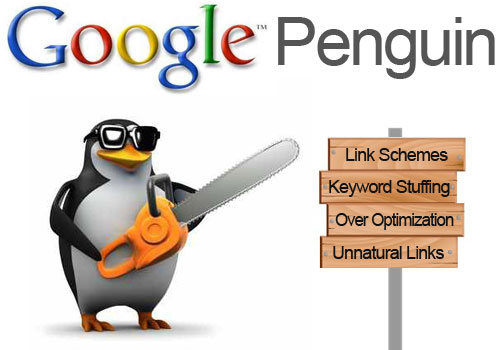
Being an internet marketing company we have to stay on top of the latest changes and updates, especially those within Google. The Google Penguin update was released on April 24, 2012 and was deemed to be Google Panda’s right hand man (Google Panda tips here). Penguin’s mission is very similar to Panda in that it is aimed at removing low quality, unnatural and spammy websites. Unfortunately this update made things a lot trickier for internet marketers as the changes weren’t just about increasing the quality of content and pages on a website, but rather about inbound backlinks and those who are linking to you which could potentially be out of your control.
On the surface from our understanding, it meant that your competition could potentially create backlinks that were unnatural and over-optimized and send them to your website in an effort to affect your rankings. But, it looks like it’s not quite that simple (albeit possible), as nothing ever is with Google. Panda and Penguin will continue to work in unison and the three tips below were relevant the day Google Penguin was released and will be relevant from now and into the future. If you want to avoid penalties you must follow Penguin’s quality guidelines and keep an eye on the quality of your website and your backlink profile, and who and how others are linking to you.
Google Penguin SEO Tips
#1 – Vary Your Anchor Text
The penguin update directly targeted what Google calls over-optimization (negative SEO). When you create backlinks to your website you include a hyperlink with text in that link which is clickable to your desired website or web page. This text may be the words: “click here,” “check this out,” your websites name, full URL, or most desirable -the keywords that you are trying to rank for. Since more ranking weight is placed on having the exact match keywords as your anchor text, that’s where those doing SEO focused most of their efforts. Websites whose backlink profile had a substantially high percent of exact match keywords versus “natural” backlink anchor text were directly affected by the update. The anchor text that you choose should not only be focused on the keywords you want to rank for or you could be penalized for over optimization as this does not look natural. When a third person links to your website, it is far less common for them to choose the associated keywords that you want to rank for, versus natural sharing and saying for instance “you can find it here,” or “at this website.” For every exact match keyword you build, you should build approximately two random anchor text backlinks to be safe.
#2 – Don’t Participate in Paid Link Networks
Low quality link networks were a massively abused system that was aiding in ranking low quality websites in the serps quite easily because their backlink profiles were very strong. Some high quality websites also participated in these link schemes and ultimately paid the price when they were discovered and sent messages to their Google Webmaster inbox. A typical paid link network might consist of fifty or even two-hundred unique domains which often have high PR, with all content and links on the homepage, since homepage backlinks carried more weight, and spun or poorly written and occasionally duplicate content. In some instances the content surrounding the links was not even on topic. For example, the post may be about vacationing in Hawaii while the backlink anchor text was “cheap auto insurance.” The indexed websites in these link networks were basically low quality and were built only for link manipulation, providing no value to visitors and therefore low quality. Penguin and efforts by the Google webspam team effectively deindexed and removed a lot of these popular paid networks (ie: ALN or Authority Link Network), and with that went the rankings of a lot of those on these types of networks.
#3 – Remain Natural and Consistent
Natural means creating content that is of superior quality and built for providing value to those who stumble upon it, not just creating content for ranking in the search engines. Natural and consistent also has to do with your efforts onsite and offsite. Since natural often takes a long time in SEO, if you intend to speed things up you need to remain consistent or it could set off some red flags within Google’s algorithm and quality checks. Build small amounts of links daily versus large blasts out of nowhere. Also, consistently publish high quality content on your website. If your rankings take a dip or increase out of nowhere, do not venture off your natural path; remain consistent. Google knows that many internet marketers watch their sites daily and that if they detect a drop in rankings, that they often either send a lot more links or remove something that they did recently. Don’t panic or change up your natural campaign, just keep calm and continue on as you would if nothing had changed.

Share